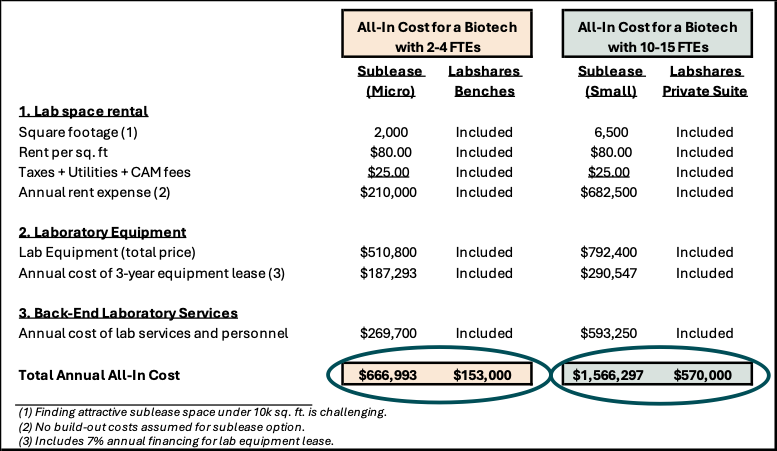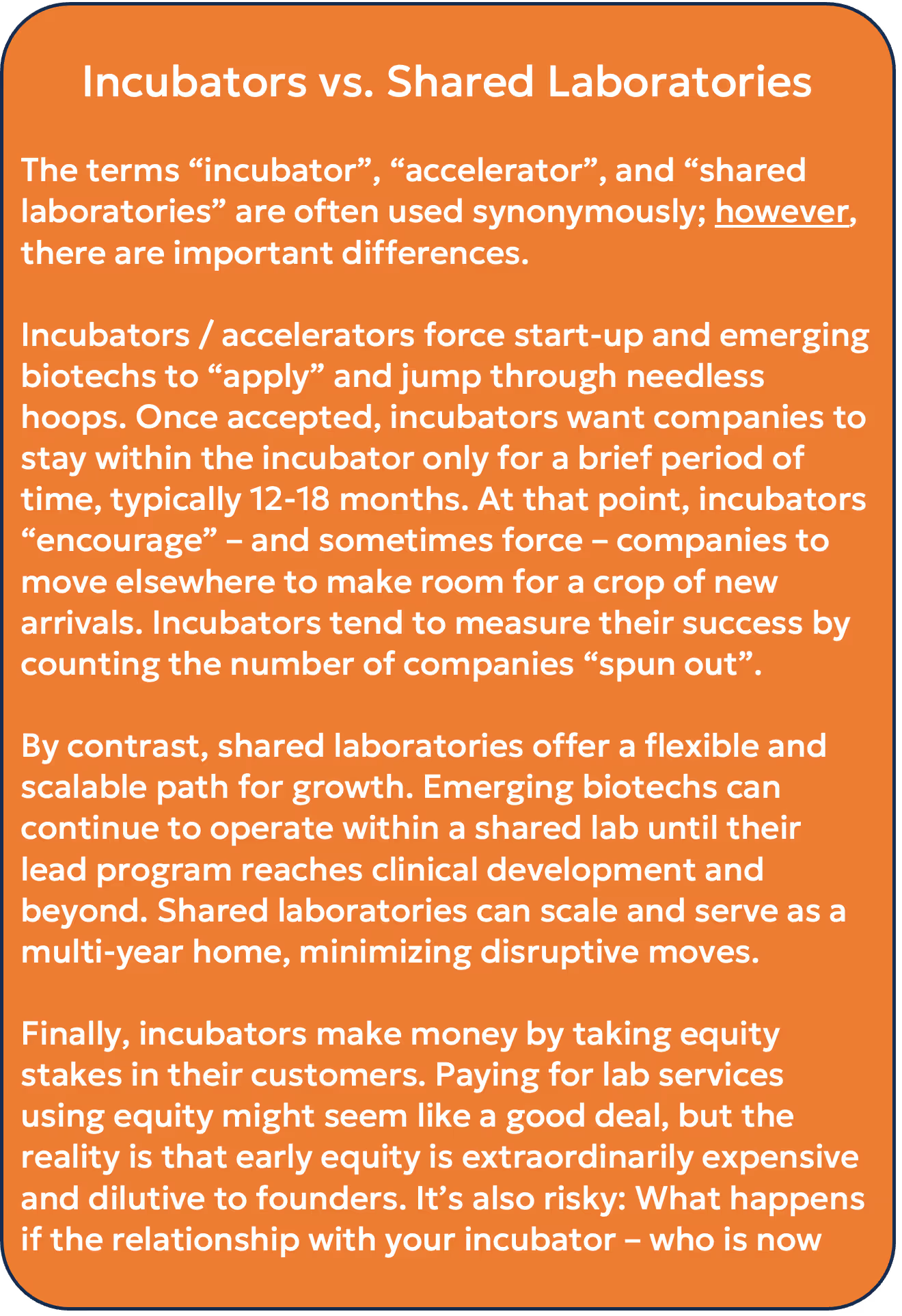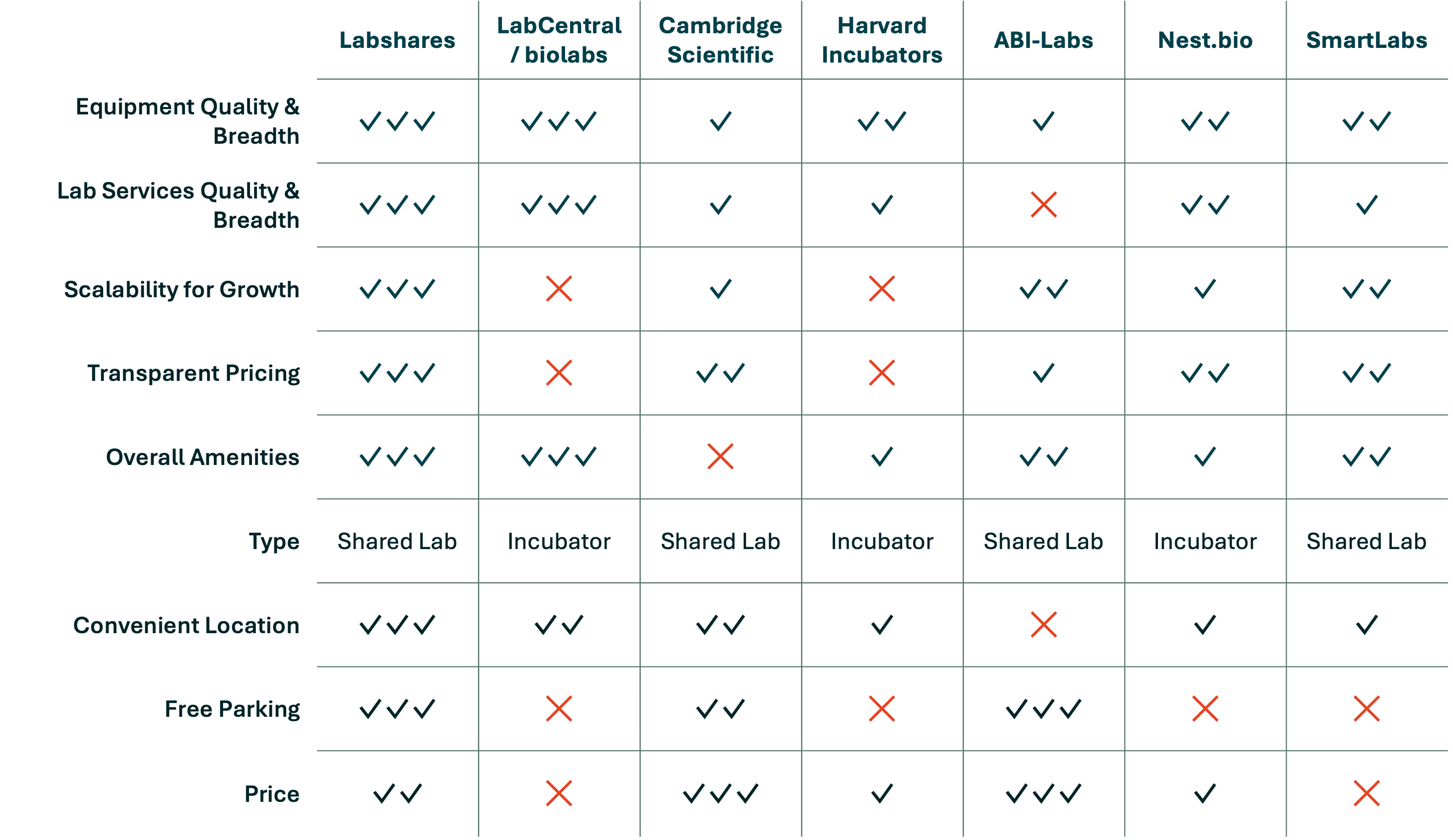- Remove the current class from the content27_link item as Webflows native current state will automatically be applied.
- To add interactions which automatically expand and collapse sections in the table of contents select the content27_h-trigger element, add an element trigger and select Mouse click (tap)
- For the 1st click select the custom animation Content 27 table of contents [Expand] and for the 2nd click select the custom animation Content 27 table of contents [Collapse].
- In the Trigger Settings, deselect all checkboxes other than Desktop and above. This disables the interaction on tablet and below to prevent bugs when scrolling.
White Paper
Shared Laboratories
The Preferred Path for Emerging Biotech
Why are shared labs a better solution? How to select the right one?
Summary
Historically, emerging biotechnology and life science companies have struggled to find suitable solutions that meet their laboratory infrastructure needs. The only viable options required committing to a long-term lease, purchasing expensive lab equipment, and creating back-end lab management expertise. Shared laboratories address each of these historic challenges and are now the preferred option for start-up and emerging biotechs.
This white paper (I) highlights the key benefits of shared labs, (II) details the criteria to select a shared laboratory, and (III) directly compares several shared laboratory and incubator options in the greater Boston / Cambridge area.
Introduction: Why Picking a Lab Is So Critical

Start-up and emerging biotechs serve as the lifeblood for the entire pharma and biotech industry. These essential companies must show rapid scientific progress but do so with limited resources. This is particularly true in today’s capital-constrained environment, where hitting key scientific milestones can be the difference between a successful next fundraise and company death.
Along with personnel costs, the most significant cost for emerging biotech is infrastructure – i.e., laboratory and office space, advanced scientific equipment, and associated back-end lab services. Thus, early lab infrastructure decisions can profoundly impact a biotech's trajectory and probability of success.
The Problem for Emerging Biotech
Historically, there has been a poor fit between the lab infrastructure needs of emerging biotech companies and the options available, leading to several challenges:
- <u>Timeline mismatch</u>: Typical lab leases require 5+ year commitments. Emerging biotechs are loath to make a commitment for that long because they tend to raise capital based on milestone achievements, roughly every 1-3 years.
- <u>Flexibility mismatch</u>: Emerging biotechs start off very small – often within only 1-2 scientists – but aim to expand as their science advances. Typical lab leases and subleases force emerging biotechs to rent excess space since it is nearly impossible to flex up their lab once locked into a contractual commitment.
.avif)
- <u>Lab build-out</u>: Emerging biotechs have to build out and customize their own leased or subleased space. This build-out is costly, time consuming, and not core to advancing their science.
- <u>Equipment is expensive</u>: Buying (or leasing) lab equipment is expensive and capital inefficient.
- <u>Equipment is underutilized</u>: Most emerging biotechs only utilize their equipment periodically, making it inefficient to own or lease directly.
- <u>Substantial back-end lab services requirements:</u> Day-to-day lab management requires expertise in an array of back-end systems and support functions. These lab services – while vital – add cost and usually necessitate adding support personnel to the payroll of emerging biotechs. None of these costs directly contribute to an emerging biotech advancing its core science.
During the early 2020s, many emerging biotechs raised huge financing rounds from the venture capital community and elected to spend heavily to rent and build out their own laboratory space. Those days are over. Smart companies today know that a more disciplined, focused approach is to operate within a sophisticated, shared laboratory.
I. Shared Laboratories: The Solution for Emerging Biotech
The shared laboratory model emerged as the preferred solution for early-stage biotechs, particularly in today’s more capital-constrained environment. <b style="font-weight: 600;"><i>Why is the shared lab approach the superior option?</i></b>
- <u>Timelines that fit:</u> Shared labs offer more flexible timelines. Contracts for individual lab benches can be as short as a few months.
- <u>Flexibility for growth:</u> Start-ups can begin with only a single lab bench yet have the flexibility to grow into a private lab suite that can accommodate 20+ lab members.
- <u>Speed:</u> Within a shared lab, companies can get up and running in days, saving time and conserving cash.
- <u>Provision of equipment:</u> Lab equipment such as flow cytometers, HPLCs, autoclaves, centrifuges, PCR equipment, cell counters, biosafety cabinets, fume hoods, microscopy, cold storage, and more is provided by the shared lab company. This dramatically reduces the cash outlay for emerging biotechs. Utilizing shared lab equipment works well, as most equipment is used only periodically. The best shared labs meticulously maintain and calibrate their own equipment.
- <u>Provision of back-end lab services:</u> Shared laboratories offer a host of back-end services, including regulatory / permitting, lab safety, equipment maintenance and calibration, lab purchasing systems, medical waste removal, laboratory gases, lab coat cleaning, and more. This frees emerging biotechs to focus on their core mission of advancing their science. Shared labs also eliminate the need for emerging biotechs to hire a lab manager, saving on non-core personnel costs.
- <u>Community:</u> The best shared labs craft a vibrant, creative environment. Scientists are not isolated like they might be in rented lab space; instead, they are able to socialize and feel part of a true community of like-minded scientists and entrepreneurs.
Shared Laboratories: Much More Than “Lab Space”
High-quality shared laboratories offer much more than just “space”. Shared labs provide everything necessary for emerging biotechs to perform their science.
Three elements combine to form the core value proposition for shared labs:

The monthly fee charged by shared labs includes all three components – space, equipment, and lab services – bundled into a single price. By packaging together all three, shared lab operators create a simple and transparent solution for their emerging biotech customers.
By contrast, traditional lab leases and subleases only account for the lab space component. The laboratory rent typically does not include lab equipment or lab services or utilities, all of which the emerging biotech must pay for on its own.
Cost Comparison: Lease / Sublease vs. Shared Laboratory
To understand the true cost of operating a lab, we’ve created an analysis that compares (A) the total cost for a laboratory sublease, including rent, equipment and lab services, and (B) the total cost for a shared laboratory.


The above analysis shows that the total cost of leasing / subleasing is substantially more expensive for emerging biotechs than a shared laboratory option. Note that the “lab space” /rent component – in isolation – appears to be comparable to the cost of shared lab space. <i><b style="font-weight: 300;">However </b></i>, including the cost of lab equipment and lab services (and taxes and utilities) makes it clear that shared laboratories offer far superior value.
.avif)
While the first component –lab rent – is the most visible, our analysis shows that, for the typical 10-15-person emerging biotech, lab rent only accounts for 44% of the total cost to operate a laboratory. The other two components – lab equipment and lab services –account for 56% of the total costs. The contrast is even more striking for 2-4 person biotechs: lab rent accounts for only 32% of the total costs, while equipment and lab services account for nearly 68% of the total cost. (See the Appendix for additional details on this analysis.)
In short, this analysis shows that shared labs are the superior option for almost all emerging biotechs with fewer than 25 employees and who’ve raised less than $120 million in capital.
Shared Laboratories: The Right Option in Today’s Market
Finally, the value proposition of shared laboratories is particularly compelling in today’s more cost-conscious environment. The venture capital community seems to agree:

II. How to Select a Shared Laboratory
Shared laboratories have become the preferred option for emerging biotechs. Within the greater Boston and Cambridge biotech / life science hub, we are fortunate to have a few shared laboratory and incubator options. How is an emerging biotech to choose?
Here are the key criteria to select a shared lab / incubator:
- <u>Overall facility quality:</u> Is the facility conducive to attracting and retaining employees? Is the lab clean and inviting? Is this a place where you feel confident developing your lead drug or therapeutic candidate?
- <u>Location:</u> Is the location easy to get to? Or will employees have to suffer through long commutes in Boston / Cambridge traffic jams? Is there available (and affordable) parking? Is there access to reliable public transportation?

- <u>Scalability:</u> Does the incubator or accelerator “kick you out” after a certain timeframe? Or does it offer a scalable path for growth?
- <u>Quality and breadth of equipment:</u> Does the shared laboratory offer a wide array of high-quality lab equipment? Is the equipment new or used?
- <u>Equipment uptime:</u> Is the equipment calibrated and regularly maintained?
- <u>Quality and breadth of lab services:</u> Does the shared lab take care of medical waste? Does the staff play a helpful role in solving your problems? Is it a true BSL2 (or BSL2+) facility?
- <u>Hidden costs:</u> Is the pricing all-inclusive? Or are you “nickeled and dimed” with endless and annoying fees?
- <u>Amenities:</u> Does the shared lab space offer access to convenient amenities such as food options, tech-equipped conference rooms, bike storage, gyms, and more?
The greater Boston and Cambridge area has a rich ecosystem to support start-up and emerging biotech and life science companies. Below is a summary that compares the leading shared labs and incubators along the key dimensions:

III. The Labshares Difference
How does Labshares differentiate itself among shared lab and incubator options?
First, we operate in the “Goldilocks zone” of greater Boston biotech: We’re only a short drive from downtown Boston and Kendall Square and offer a far easier commute and abundant free parking compared to other shared lab spaces. No more wasted time in traffic jams or paying through your teeth just to park! We’re also close to public transportation and have available on-site bike storage.

Second, we are committed to helping you succeed and grow here at Labshares. Unlike incubators, we don’t make you wade through an annoying application and then kick you out after 12-18 months. We are scalable, providing a clear pathway to grow within our flexible lab space. Our customers often start by licensing 1-2 lab benches. As they succeed, they expand into a small private lab suite, and then ultimately graduate into a large private lab suite. Labshares’ scalable model minimizes downtime and eliminates disruptive re-locations.
Third, we don’t surprise our customers with hidden “one-time” fees or equipment usage fees. Unlike some of our competitors, Labshares’ pricing is all-inclusive and highly transparent.
Fourth, we purchase new, cutting-edge scientific equipment which we meticulously maintain. Our equipment has historically had 99%+ uptime. This allows our customers to focus on the science without having to worry about re-calibrating and fixing equipment.
Fifth, our staff has deep scientific expertise and specializes in helping you to solve your scientific problems. Our entire aim is to help you get up and running quickly and to help you meet your milestones.
Finally, Labshares fosters a connected and caring community. It’s a place where our members feel engaged and energized. We host a variety of social events, lunch and learns, and other programs that help to make Labshares feel like a true home.
Labshares: It’s science, streamlined.
Appendix
<i> Below are additional details on the total cost of lab equipment and lab services for emerging biotechs (this analysis focuses on emerging biotechs with 10-15 employees):</i>

